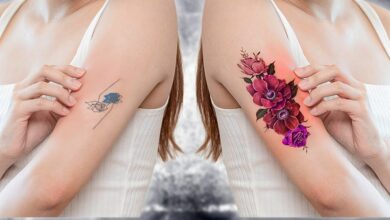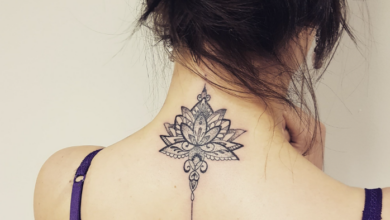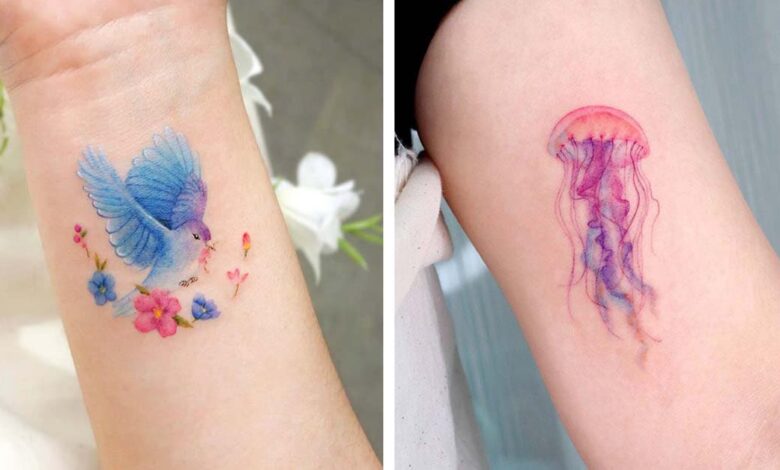
Dive into the vibrant world of watercolor tattoos with this article from stylish.ae. We’re taking a close look at these stunning tattoos that mimic the flow and hue of watercolors, transforming skin into art. Whether it’s the gentle sweep of a floral design or the lively depiction of an animal, watercolor tattoos offer a fresh, creative way to express your style. Join us to explore the imaginative realm of these tattoos that make every design a personal masterpiece.

What Are Watercolor Tattoos?
Watercolor tattoos are a unique style of body art that mimic the aesthetics of watercolor paintings. Unlike traditional tattoos that use bold lines and shading, watercolor tattoos use lighter colors and flowing brushstrokes to create a more ethereal and painterly effect. These tattoos are known for their soft and dreamy appearance, often incorporating a blend of colors with minimal black accents. Watercolor tattoos have gained popularity in recent years due to their striking visual appeal and ability to create a more personalized and artistic tattoo experience.
Characteristics
One of the defining characteristics of watercolor tattoos is their blendability. Unlike solid colors in traditional tattoos, watercolor tattoos can seamlessly blend multiple shades together to create a more fluid and organic appearance. This blending technique allows for smoother transitions between colors and can give the tattoo a more dynamic and artistic look.
Another important characteristic of watercolor tattoos is their transparency. Watercolor pigments are often diluted with water to create a translucent effect, and this same principle is applied to watercolor tattoos. By using lighter pigments and layering them with varying degrees of opacity, tattoo artists can achieve a delicate and ethereal quality that is reminiscent of watercolor paintings.
Vibrant colors are also a key feature of watercolor tattoos. While traditional tattoos often rely on bold and saturated hues, watercolor tattoos make use of a wide range of vibrant colors to create an eye-catching and visually stunning design. From soft pastels to bright and bold shades, watercolor tattoos can be as vivid or subtle as desired, allowing for endless possibilities in terms of color combinations and effects.
Lastly, watercolor tattoos often incorporate abstract effects. Inspired by the freeness and unpredictability of watercolor paintings, these tattoos can incorporate splatters, drips, and soft edges to create a sense of movement and spontaneity. These abstract details give watercolor tattoos a unique and artistic touch that sets them apart from other tattoo styles.
Inspiration from Watercolor Painting
Watercolor tattoos draw inspiration from the beautiful and expressive art form of watercolor painting. Just as watercolor paints are known for their translucent colors and fluid brushstrokes, watercolor tattoos aim to replicate these qualities on the skin. The softness and subtlety of watercolor paintings translate well onto the human canvas, creating a truly breathtaking and one-of-a-kind tattoo experience.
Watercolor paintings often feature delicate and intricate depictions of nature, landscapes, and abstract shapes, and these themes are frequently incorporated into watercolor tattoos as well. Artists take inspiration from the vast array of subjects explored in watercolor paintings and apply them to their tattoo designs, resulting in stunning and highly personalized works of art.

Unique Features of Watercolor Tattoos
Blendability
One of the most distinctive features of watercolor tattoos is their blendability. Unlike traditional tattoos, which rely on clear and defined lines, watercolor tattoos allow for a more fluid and organic blending of colors. Tattoo artists can create smooth transitions between different shades, giving the design a more seamless and natural appearance. The ability to blend colors in such a way adds depth and dimension to watercolor tattoos, further enhancing their visual appeal.
Transparency
Transparency is another unique feature of watercolor tattoos. As with watercolor paintings, watercolor tattoos make use of transparent and translucent pigments, allowing the skin to show through the tattoo. This creates a soft and ethereal effect that is not typically seen in traditional tattoo styles. The transparency of watercolor tattoos adds to their overall delicacy and gives them a dreamy and almost otherworldly quality.
Vibrant Colors
Vibrant colors are a hallmark of watercolor tattoos. Unlike traditional tattoos that often feature bold and saturated hues, watercolor tattoos can incorporate a wide range of bright and lively colors. From soft pastels to vivid and intense shades, watercolor tattoos offer a vast spectrum of color possibilities. This versatility allows individuals to choose colors that best represent their personal style and preferences, resulting in truly unique and eye-catching tattoos.
Abstract Effects
Watercolor tattoos are known for their incorporation of abstract effects. Inspired by the freeness and unpredictability of watercolor paintings, tattoo artists often add splatters, drips, and soft edges to their designs. These abstract elements mimic the natural flow of watercolor pigments, creating a sense of movement and spontaneity within the tattoo. These abstract effects not only add visual interest but also contribute to the overall artistic and painterly look of watercolor tattoos.
Popular Watercolor Tattoo Designs
Watercolor tattoos can be found in a wide range of designs, but there are several popular themes that are frequently seen in this style.
Flowers and Nature
One of the most common designs for watercolor tattoos is the inclusion of flowers and other elements of nature. Whether it’s a single delicate blossom or a full bouquet of vibrant blooms, flowers make for stunning watercolor tattoos. The soft and flowing nature of watercolor tattoos pairs perfectly with the delicate petals and intricate details of flowers, creating a harmonious and visually captivating design. Other elements of nature, such as leaves, trees, and animals, can also be incorporated into watercolor tattoos to further enhance the natural theme.

Animals
Watercolor tattoos featuring animals are also quite popular. The fluid and expressive nature of watercolor tattoos lend themselves well to capturing the grace and beauty of various animal species. Whether it’s a majestic lion, a delicate butterfly, or a curious fox, watercolor tattoos can bring these creatures to life with a vibrant and painterly effect. The use of flowing lines and subtle color transitions in watercolor tattoos can emphasize the natural movement and characteristics of animals, resulting in a visually stunning and highly personalized tattoo.
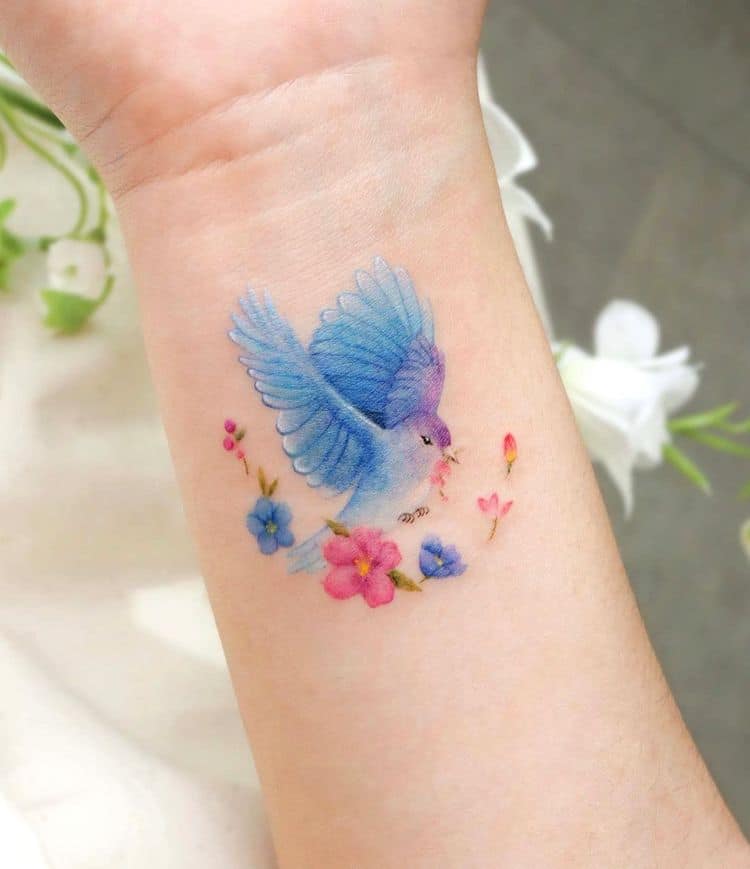
Geometric Patterns
Combining the abstract and fluid qualities of watercolor tattoos with geometric patterns can create a visually striking design. Geometric shapes, such as triangles, circles, and squares, can be overlaid or intertwined with watercolor elements to create a unique and visually intriguing tattoo. The contrast between the precise and straight lines of the geometric patterns and the soft and flowing colors of the watercolor adds an interesting dynamic to the overall design. Geometric watercolor tattoos are a popular choice for those seeking a more modern and contemporary tattoo style.
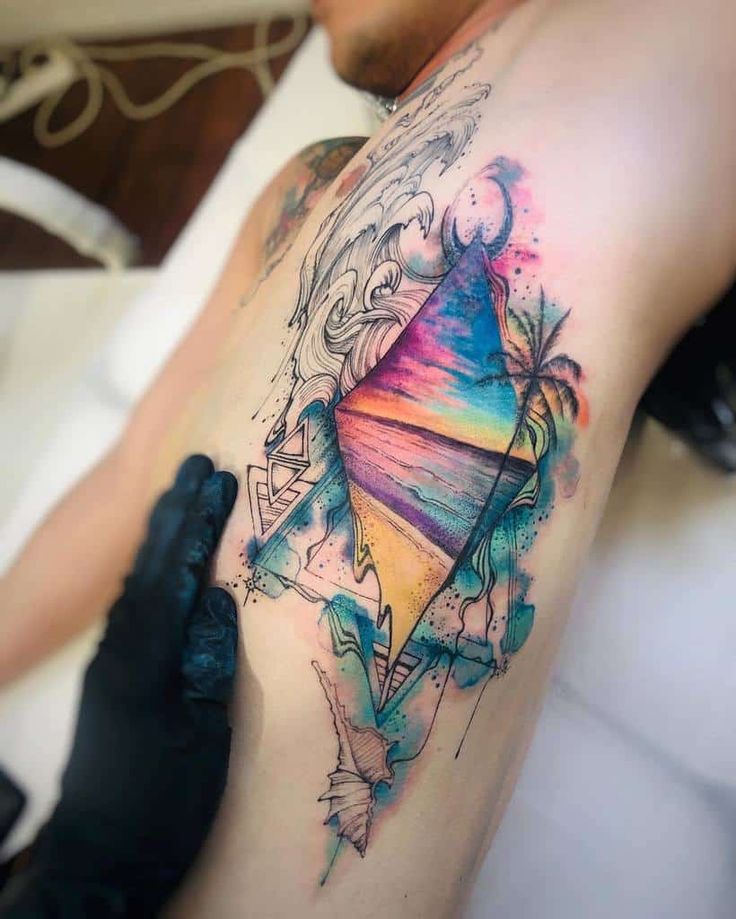
Portraits
Portraits are another popular subject for watercolor tattoos. The gentle and translucent qualities of watercolor tattoos can create a soft and realistic effect when applied to portraiture. Watercolor tattoos of loved ones or inspirational figures can evoke a sense of emotion and personal connection. Tattoo artists skilled in watercolor techniques can capture the likeness and expression of individuals, bringing their portraits to life with a beautiful and painterly touch.

Abstract Shapes
Watercolor tattoos can also be purely abstract in nature, featuring flowing shapes, splatters, and drips. These abstract tattoos allow for a greater range of creativity and personal expression. The use of vibrant colors and organic forms in abstract watercolor tattoos can result in visually striking and thought-provoking designs. These tattoos offer individuals the opportunity to express their unique personality and creativity in a bold and artistic way.

Choosing the Right Tattoo Artist
When considering a watercolor tattoo, it’s crucial to choose the right tattoo artist to bring your vision to life. Here are some important factors to consider when selecting a tattoo artist for your watercolor tattoo.
Researching Artists
Start by researching tattoo artists who specialize in watercolor tattoos. Look for artists who have a strong portfolio of watercolor work and a style that resonates with your aesthetic preferences. Online forums, social media platforms, and tattoo conventions are all excellent sources for finding talented and reputable watercolor tattoo artists.
Reviewing Portfolios
Take the time to review the portfolios of potential tattoo artists. Look closely at their previous watercolor tattoo work to get a sense of their skill level, attention to detail, and artistic style. Pay attention to the quality of their line work, color blending, and overall composition. A thorough review of their portfolio will help you determine whether their artistic style aligns with your vision for your watercolor tattoo.
Attending Consultation
Once you have identified a few potential artists, schedule consultations with them to discuss your tattoo ideas and vision. During these consultations, be prepared to ask questions such as their experience with watercolor tattoos, their process, and any concerns you may have. Pay attention to their communication style, enthusiasm for the project, and willingness to listen to your ideas. A positive and open rapport with your chosen artist is essential for a successful collaboration.
Considering Experience
Consider the experience level of the tattoo artist when making a decision. While it’s important to support emerging artists, watercolor tattoos require a certain level of skill and technique. Look for an artist with a solid foundation in traditional tattooing as well as a specialization in watercolor techniques. An experienced artist will have a better understanding of color theory, composition, and the challenges unique to watercolor tattoos.
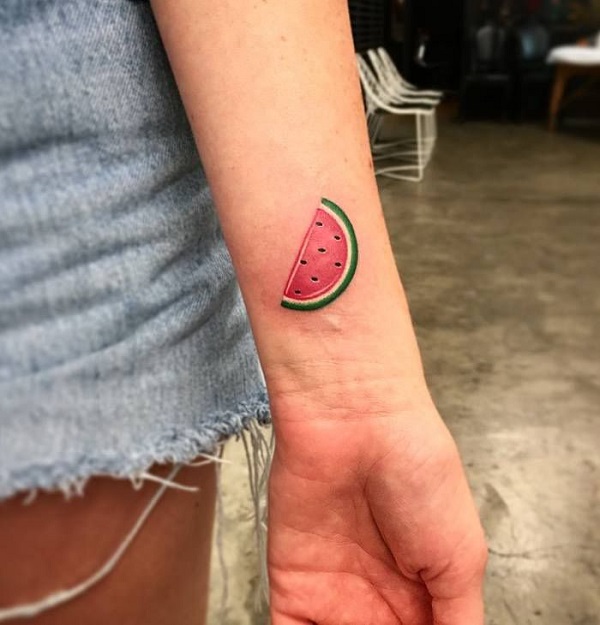
Preparing for a Watercolor Tattoo
Before getting a watercolor tattoo, there are several considerations to keep in mind to ensure the best possible outcome.
Location and Size
Decide on the location and size of your watercolor tattoo carefully. Consider the visibility of the tattoo and how it will interact with your existing body art or future tattoo plans. Keep in mind that larger, more intricate watercolor tattoos may require multiple sessions to complete, so be prepared for the time commitment involved.
Skin Preparation
Preparing your skin for a watercolor tattoo is crucial for optimal results. A few weeks before your appointment, make sure your skin is healthy and well-hydrated. Moisturize regularly to improve skin elasticity, which can help with the healing process. Avoid excessive sun exposure and tanning beds, as sunburned or tanned skin may not hold colors as well.
Avoiding Sun Exposure
In the weeks leading up to your watercolor tattoo appointment, it’s important to avoid excessive sun exposure. Sunburn can have adverse effects on the healing process and may cause the colors in your tattoo to fade or blur. If you plan to spend time outdoors, be sure to apply sunscreen generously and wear protective clothing to shield your skin from the sun’s harmful rays.
Hydration and Moisturization
During the weeks leading up to your watercolor tattoo appointment, it’s essential to keep your skin hydrated and moisturized. Drink plenty of water to ensure your skin is well-hydrated from the inside out. Additionally, use a gentle and fragrance-free moisturizer to keep your skin hydrated and supple. Well-hydrated skin can better absorb the pigments and promote faster healing.
The Watercolor Tattoo Process
Getting a watercolor tattoo involves several steps and considerations to ensure the best possible outcome.
Designing the Tattoo
Before the tattooing process begins, the artist will consult with you to design the tattoo. This is your opportunity to discuss your ideas, provide reference images, and share your vision with the artist. Be open to their creative input and expertise, as they can help refine your ideas and suggest improvements for the design. Once the design is finalized, the artist will create a stencil to guide the tattooing process.
Application Techniques
Watercolor tattoos require specific application techniques to achieve the desired effect. Tattoo artists skilled in watercolor techniques use freestyle methods to apply the pigments, often using a combination of conventional tattooing techniques and watercolor painting techniques. This blending of techniques allows for the soft edges and translucent quality that are characteristic of watercolor tattoos.
Allowing for Variations
Watercolor tattoos are inherently unique and often unpredictable. Due to the nature of the style, it is essential to be open to the possibility of variations in the final result. The blending of colors and abstract effects can vary from artist to artist, and no two watercolor tattoos will be exactly alike. Embrace the individuality of your own tattoo and appreciate the artistic expression that watercolor tattoos offer.
Healing and Aftercare
After getting a watercolor tattoo, it is crucial to follow proper aftercare instructions to ensure optimal healing and color retention. Your tattoo artist will provide detailed instructions for cleaning and moisturizing the tattooed area. It’s important to avoid direct sunlight, swimming pools, saunas, and excessive sweating during the initial healing period. Following the artist’s instructions and keeping the tattoo clean and moisturized will help the colors stay vibrant and prevent infection.
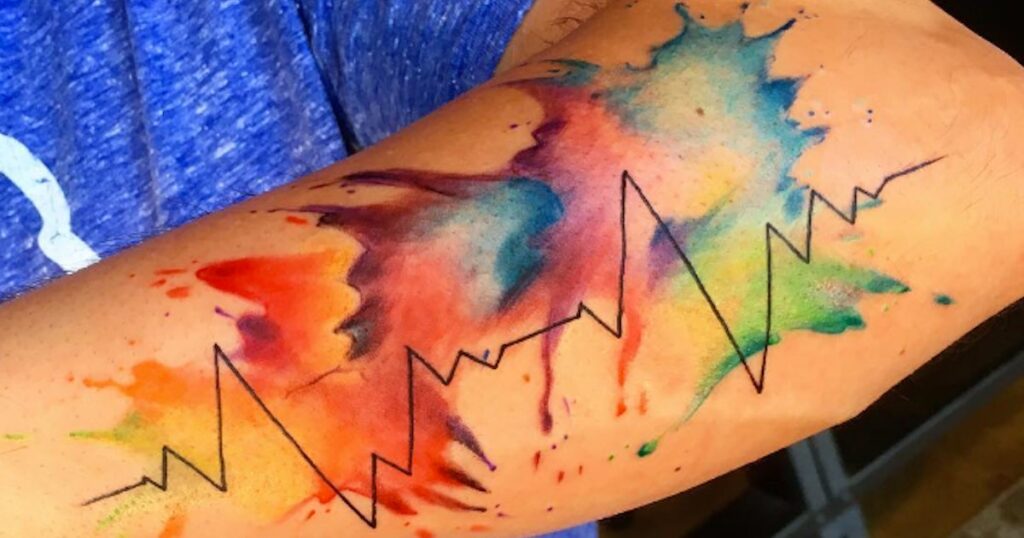
Caring for a Watercolor Tattoo
Proper aftercare is crucial for maintaining the vibrancy and longevity of a watercolor tattoo. Here are some essential care tips to keep in mind:
Avoiding Direct Sunlight
Protect your watercolor tattoo from direct sunlight, as prolonged exposure to the sun can cause the colors to fade or blur. When spending time outdoors, seek shade or cover the tattoo with clothing or sunscreen. It’s recommended to use a broad-spectrum sunscreen with a high SPF to shield the tattooed area from harmful UV rays.
Using Gentle Cleansers
When cleaning your watercolor tattoo, use a gentle cleanser that is free of harsh chemicals or fragrances. Avoid scrubbing the tattoo, as this can damage the delicate skin and cause the colors to fade. Pat the tattoo dry with a clean towel instead of rubbing it to avoid unnecessary friction.
Moisturizing Regularly
Moisturizing regularly is essential for maintaining the health and vibrancy of your watercolor tattoo. Apply a fragrance-free and non-comedogenic moisturizer to the tattooed area at least twice a day or as directed by your tattoo artist. Keeping the skin well-hydrated promotes faster healing and helps retain the vividness of the colors.
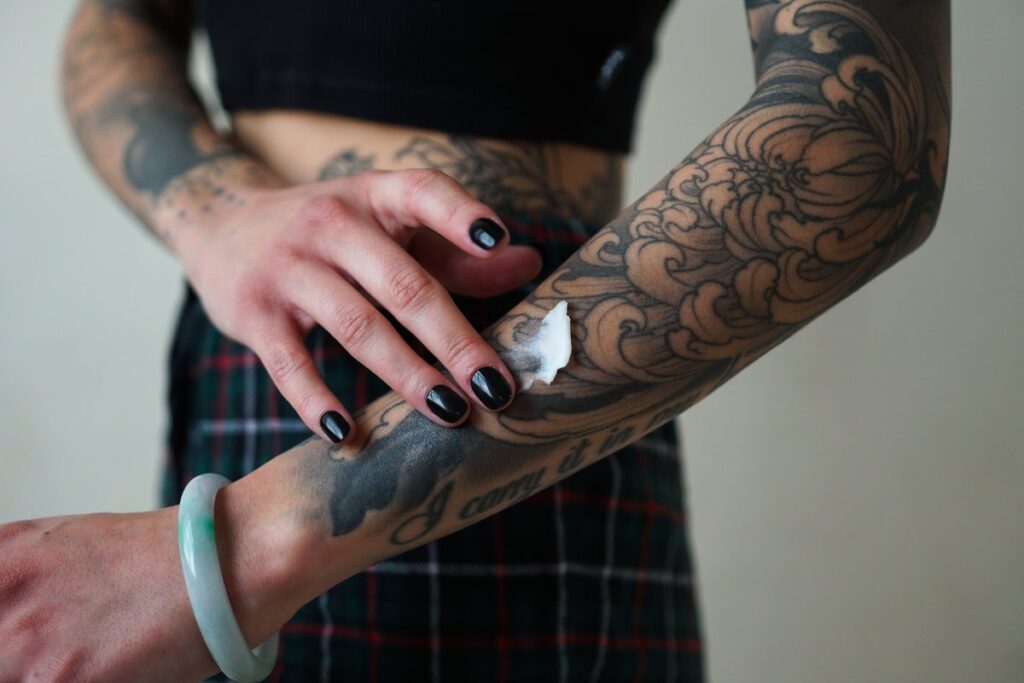
Protecting from Scratches
Avoid scratching or picking at your watercolor tattoo, as this can cause damage to the delicate skin and disrupt the healing process. If the tattoo feels itchy, gently tap or pat the area instead of scratching. Wearing loose-fitting clothing and ensuring the tattooed area is not in contact with rough surfaces can also help prevent accidental scratches.
Pros and Cons of Watercolor Tattoos
Watercolor tattoos offer unique aesthetics and personal expression but also have some limitations. Here are the pros and cons to consider before getting a watercolor tattoo:
Pros: Unique Aesthetics
Watercolor tattoos provide a visually striking and unconventional aesthetic that sets them apart from traditional tattoo styles. The soft and flowing colors, blendability, and abstract effects of watercolor tattoos create a truly artistic and individualized piece of body art. These tattoos can be a great option for those seeking a more delicate and ethereal look.
Pros: Personal Expression
Watercolor tattoos allow for a high degree of personal expression and creativity. The unique blending of colors, abstract effects, and incorporation of various themes and subjects make watercolor tattoos highly customizable. Whether it’s a meaningful symbol, a favorite animal, or a representation of nature, watercolor tattoos offer individuals an opportunity to showcase their personal style and stories.
Cons: Fading and Blurring
One of the main considerations with watercolor tattoos is the potential for fading and blurring over time. Watercolor tattoos tend to be more delicate than traditional tattoos and may require more frequent touch-ups to maintain their vibrancy. Factors such as sun exposure, age, and skin type can all affect how well the colors in a watercolor tattoo hold up over time.
Cons: Limited Tattoo Options
While watercolor tattoos offer a wide range of possibilities within their style, they may not be suitable for every design or concept. Watercolor techniques work best with certain subjects, such as flowers, nature, and abstract shapes. Intricate details and precise line work may not fare well with the fluidity and blendability of watercolor tattoos. It’s essential to discuss your ideas with a skilled artist to determine if a watercolor tattoo is the best choice for your desired design.
Famous Watercolor Tattoo Artists
Several talented tattoo artists have made a name for themselves in the watercolor tattooing community. Here are a few notable artists known for their expertise in watercolor tattoos:
Emily Kaul
Emily Kaul is a highly regarded watercolor tattoo artist based in the United States. Known for her delicate and vibrant watercolor-style tattoos, Emily’s work often features dreamy landscapes, nature elements, and animals. Her meticulous attention to detail and ability to capture the essence of watercolor paintings have earned her a loyal following of clients.
Wendy Pham
Wendy Pham is a respected watercolor tattoo artist based in Vietnam. Her unique style combines watercolor techniques with Asian-inspired designs, resulting in visually compelling and culturally rich tattoos. Wendy’s attention to detail and ability to seamlessly blend colors have earned her recognition among watercolor tattoo enthusiasts worldwide.
Gemma Pariente
Gemma Pariente is a talented watercolor tattoo artist from Spain. Her distinctive style features vibrant and bold colors, combined with intricate linework and abstract effects. Gemma’s ability to capture the essence of watercolor paintings in her tattoos has garnered her a strong following and numerous accolades in the tattoo community.
Tips for Maintaining Color and Longevity
To maintain the color and longevity of a watercolor tattoo, it’s important to follow these tips:
Regular Touch-Ups
Watercolor tattoos may require regular touch-ups to maintain their vibrancy. The colors in watercolor tattoos tend to fade and blur more quickly than traditional tattoos, so scheduling touch-up sessions with your tattoo artist can help keep your tattoo looking fresh and vibrant.
Protective Clothing and Sunscreen
When spending time outdoors, protect your watercolor tattoo by wearing loose-fitting clothing that covers the tattooed area. Applying a broad-spectrum sunscreen with a high SPF can also provide additional protection from the sun’s harmful UV rays, preventing premature fading or discoloration.
Avoiding Chemical Exposure
Avoid exposing your watercolor tattoo to harsh chemicals, such as chlorine or bleach. Substances like these can cause the colors in the tattoo to fade or blur. If you need to use cleaning products or chemicals, be sure to protect your tattoo by covering it or wearing gloves.
Moderate Water Exposure
While water exposure is generally not a problem for healed watercolor tattoos, it’s best to avoid prolonged immersions in water, such as long baths or swimming in chlorinated pools. Excessive exposure to water can degrade the colors and cause them to fade or blur. If you do engage in water-related activities, make sure to gently pat your tattoo dry afterward and moisturize as needed.
In conclusion, watercolor tattoos are a unique and visually captivating style of body art. With their blendability, transparency, vibrant colors, and abstract effects, watercolor tattoos offer a softer and more artistic alternative to traditional tattoo styles. By selecting a skilled tattoo artist who specializes in watercolor techniques and following proper aftercare guidelines, you can enjoy a stunning and long-lasting watercolor tattoo that showcases your personal style and creativity. Whether you choose to incorporate flowers and nature, animals, geometric patterns, portraits, or abstract shapes, watercolor tattoos provide a beautiful and expressive way to adorn your body with a work of art.


